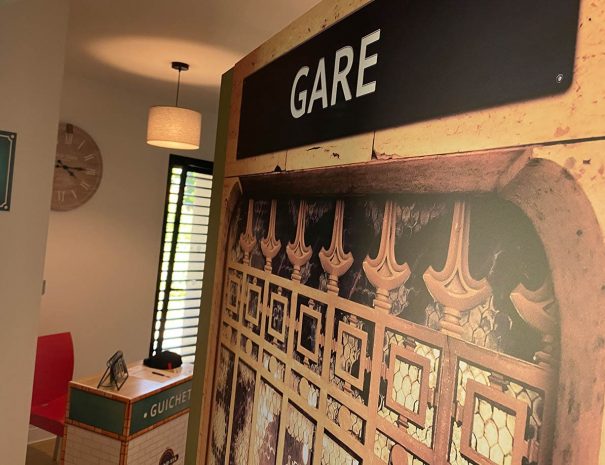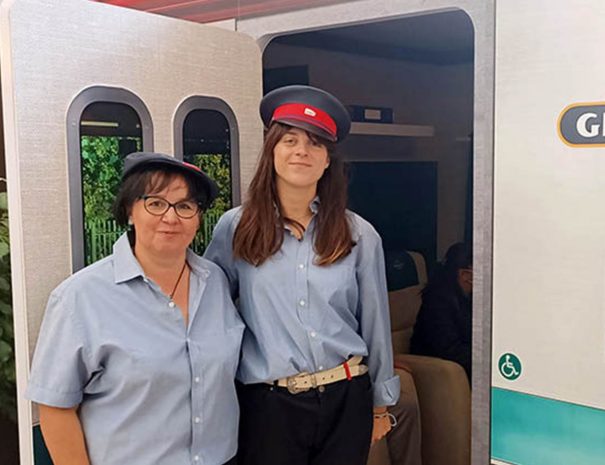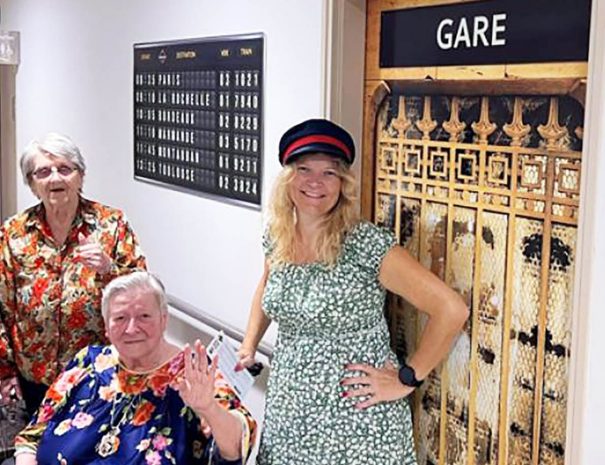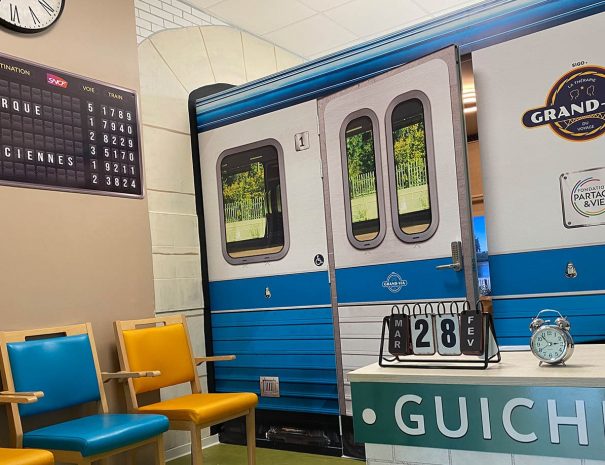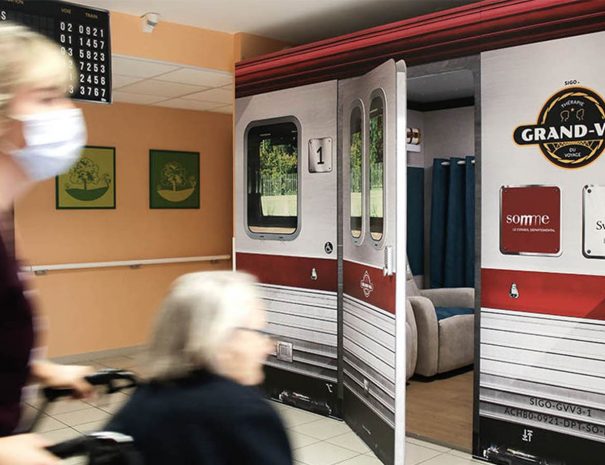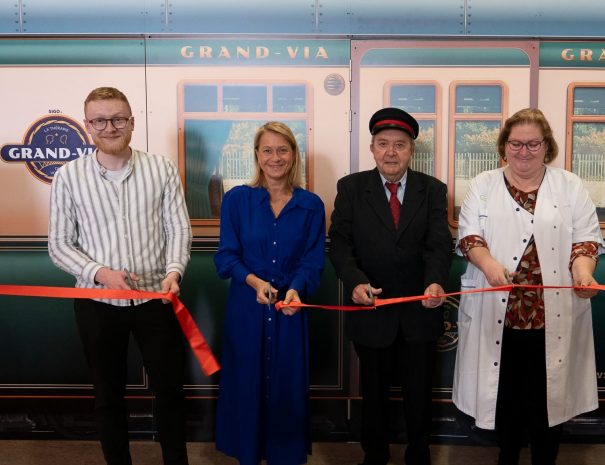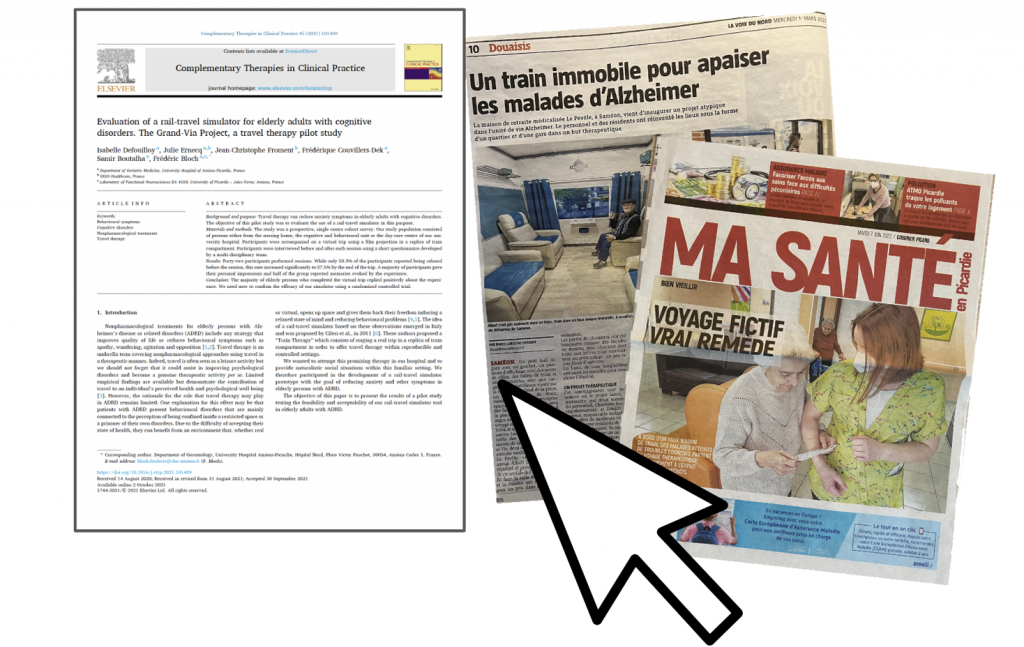Home
Discover
Travel
Therapy
AN ALZHEIMER'S INNOVATION
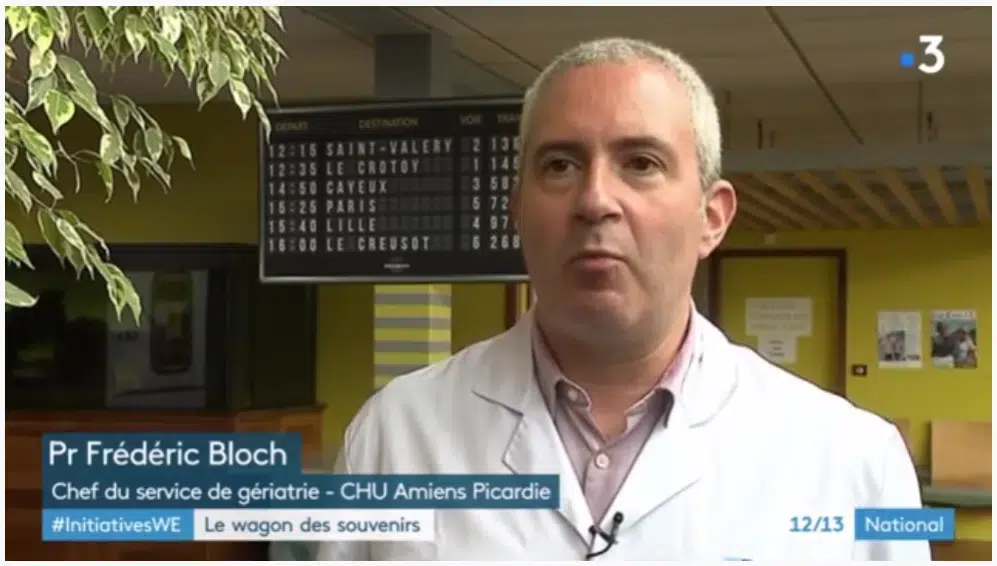
a new therapy against alzheimer's
Travel therapy in nursing homes is an immersive, virtual train ride experience that seeks to support elderly individuals with neurodegenerative diseases like Alzheimer’s.
A non-pharmaceutical treatment to fight against Alzheimer’s
Residents of participating nursing homes board the train for a 15-20 minute virtual trip , always accompanied by a professional (such as a nursing home activity coordinator, psychologist, nurse, etc.) and sometimes residents’ family members as well. Aboard the compartment, faces light up, memories resurface, and positive communication takes place. This innovative and fun experience not only provides the opportunity for residents to experience something different from their normal routine, but it also supports their overall well-being and relaxation . Importantly, travel therapy has been shown to treat many of the difficult symptoms of Alzheimer’s, such as high levels of anxiety, lack of communication, and behavioral problems such as wandering.

A fully equiped cabin ready within 3 days
A fully-equipped cabin
Residents can enjoy a first class train experience each time they step inside. Included in the apparatus are four comfortable seats, a large HDTV, an adjustable overhead light, train tickets, and other accessories that bring the whole experience to life.
Adaptable dimensions
The standard size of the cabin is 10 feet long and 8 feet in depth; however, the train car can be adapted to any size room. It’s even possible to add a front extension in order to cover the entire width of the room, for a more harmonious look.
Up to four passengers
The cabin has been designed to accommodate up to four people. The accompanying professional can therefore take up to three residents on the journey, or invite residents’ family members.

travel therapy
in videos
A new atmosphere
A lobby transformed into a train station
Laurence, an activities coordinator in a nursing home, and Frédérique, a psychologist, do everything to get the residents in the mood.
Departure at 11:15 AM, platform 2
A first-class journey
Béatrice, the coordinating physician, and Maeva, the psychologist, use travel therapy daily for maintaining communication skills and soothing.
Creating or recreating interaction
“Families to come on board”
Béatrice, director of a nursing home in France, encourages families to share travel sessions with their loved ones to work on reminiscence.
The beginnings of travel therapy
Marcel, an irresistible urge to depart
Laurence, an activities coordinator in a nursing home, and Frédérique, a psychologist, do everything to get the residents in the mood. And it works !
A journey at the zoo
The illusion is perfect
Blandine, a psychologist, and her fellow healthcare professionals take Jeannine and Huguette on a journey to treat their anxiety disorders.
Significant effects on prescriptions
Breaking free from anxiety medications
For the past year, Dr. Cnockaert has been observing the benefits of the therapy, leading to a reduction in psychotropic prescriptions and prevented their undesirable effects.
Therapeutic benefits
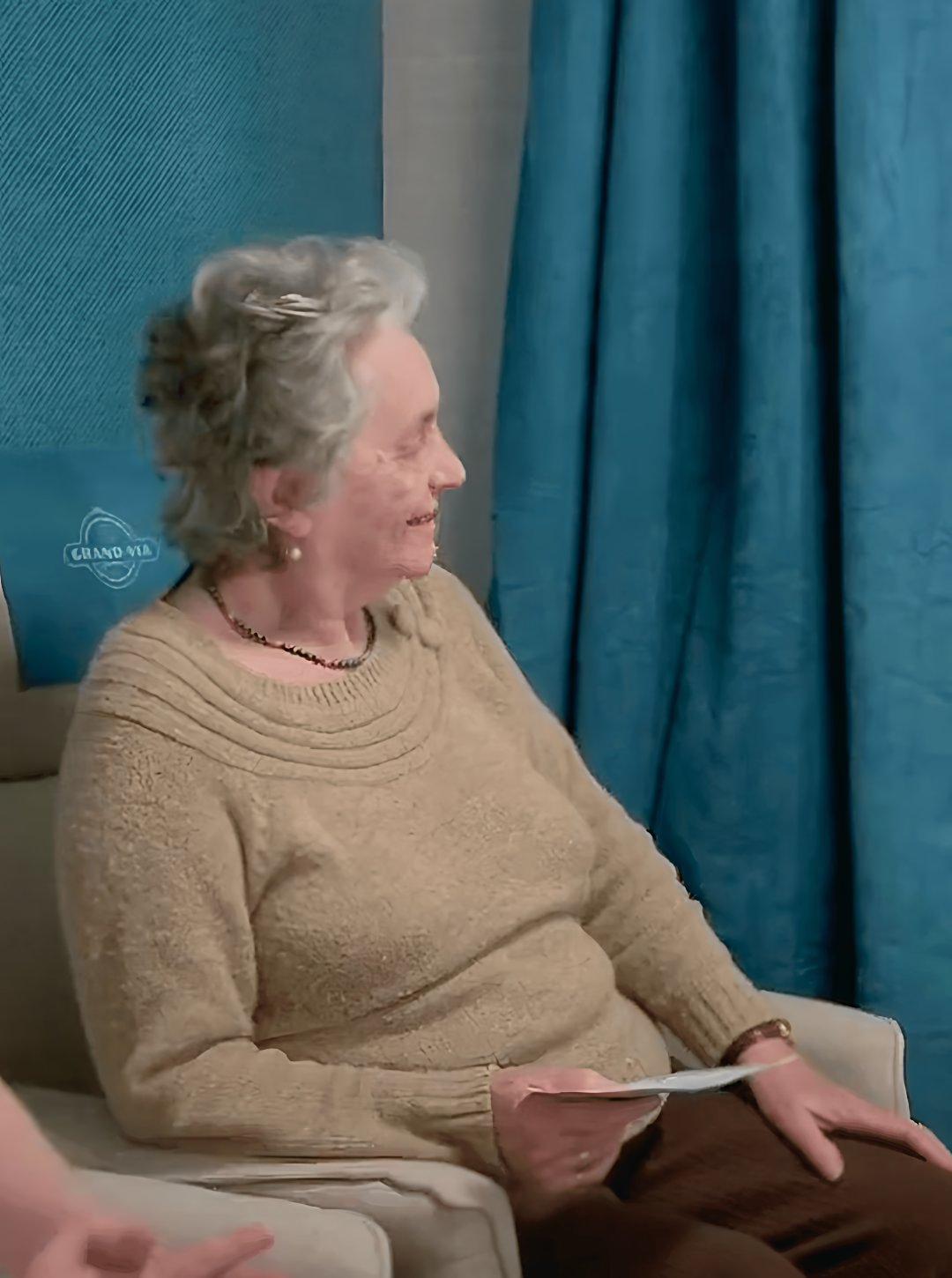
Decrease in wandering
Addressing the need to leave, the desire to "go home"...
Reduction of psycho-behavioral disorders
Such as agitation, opposition, aggression, screaming.
Stimulation of communication and dialogue
Stimulated cognition allows for the recovery of speech and non-verbal communication.
Memory stimulation
Reminiscence of memories, facilitated by immersion, the sound of the rolling train, the passing landscape...
Improved emotional expression
The therapeutic journey promotes freer emotional expression among residents, fostering a sense of emotional well-being.
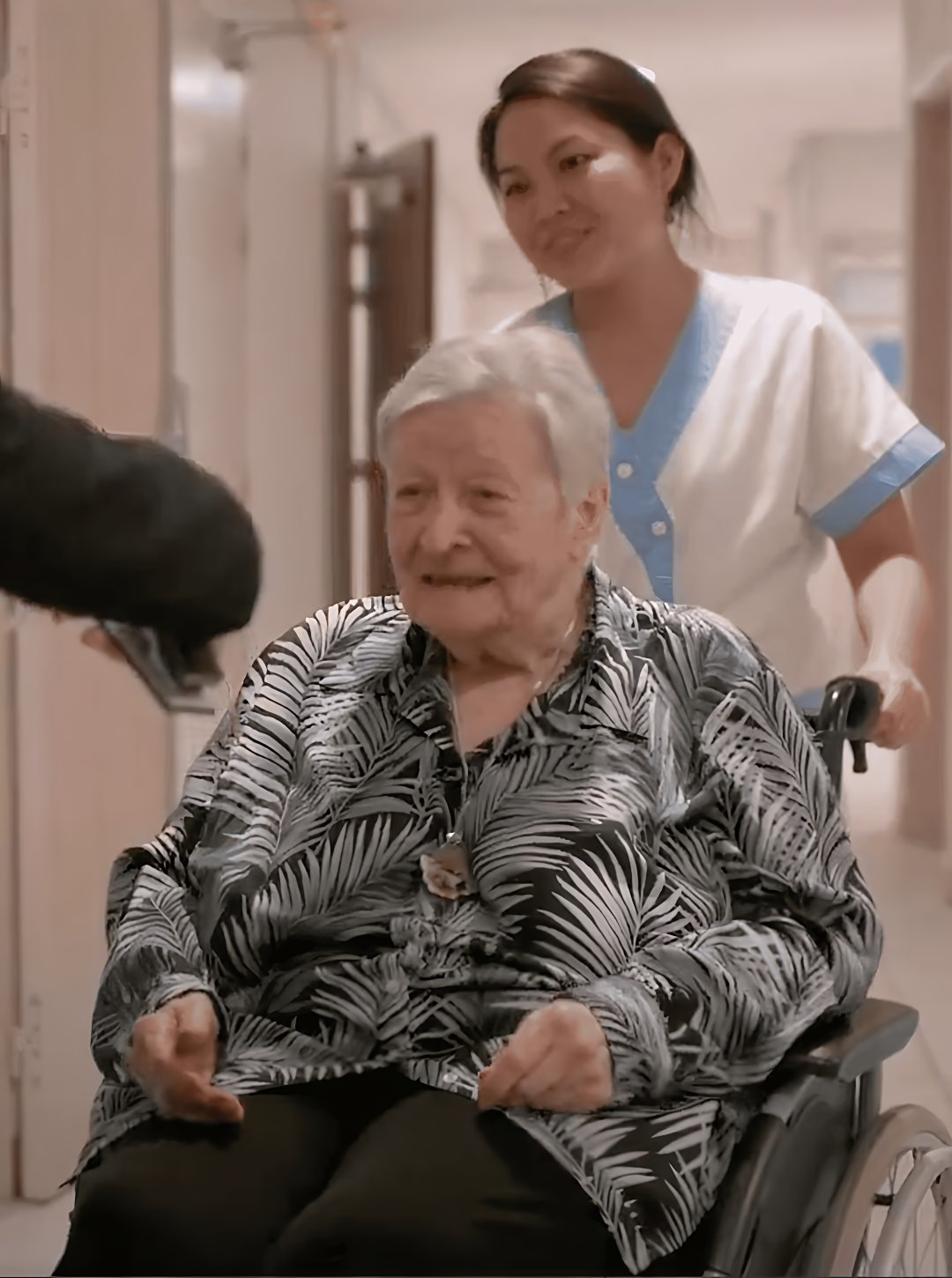
Reduction of isolation
Encourages interaction and communication between residents and caregiving staff and/or family.
Mood improvement
Positive experiences reduce symptoms of depression and apathy.
Assistance with meal intake
This pause can make it easier for residents to drink water or eat a snack or meal, and for caregivers to administer medication.
Facilitates falling asleep
The therapeutic journey assists residents in falling asleep, leading to more peaceful nights and improved overall health.
Reduction of medication
A positive influence on the well-being of residents, allowing for a reduction in the need for medications related to stress and anxiety.

caregivers' testimonials

Amélie
Occupational therapist
People with cognitive disorders often wander aimlessly, or with the intent of escaping. This wagon helps fulfill that need, allowing them to embark on a journey that may be fictitious to us but is very real to them.

Sébastien
Nurse
We have a resident who wanders a lot, covering about ten kilometers a day. For her, the therapy's effect was evident from the very first day, reducing her wandering by almost 40%.

Emanuelle
Nursing Home Administrator
It has been a fantastic period of exchange. I was initially apprehensive about the first trials because we had placed a lot of hope in this therapy. Now, there's nothing better than witnessing it in action and seeing the joy it brings.
Medical studies
and articles
Travel therapy has been the subject of a scientific paper as well as numerous articles. We are pleased to offer these downloadable articles and papers to help promote and expand this innovative therapy.
Acquisition
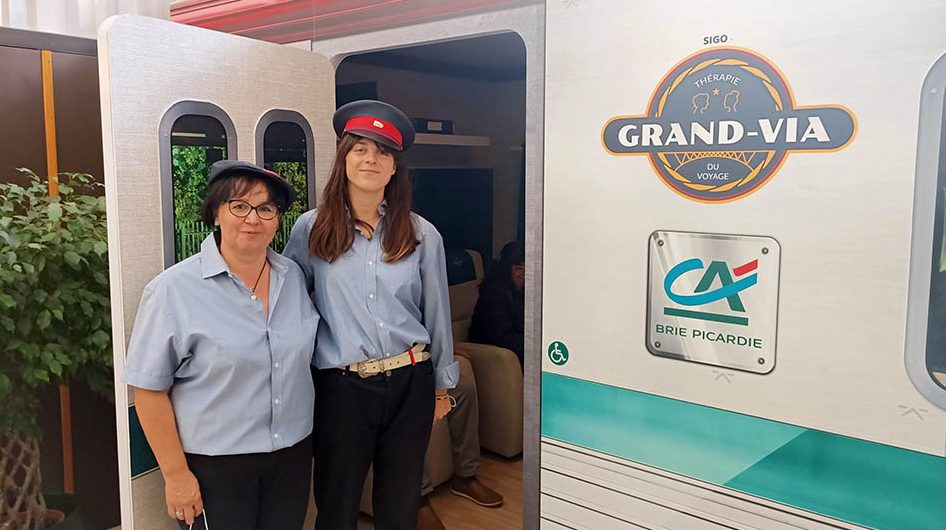
- Cabin decor
- Wall décor
- Communication kit
- Private User Forum
- Travel videos
- Face-to-face training
- User protocol
- Extension panels available
Contact US
Grand-Via - Canada
Grand-Via is THE specialist in travel therapy. Our experience built over the past few years in Europe enables us to support you effectively in implementing travel therapy in your project. Contact us now and become part of the large Grand-Via traveler community
Want to be called back?
Fill in your phone number in the form and let us know your preferred day/time in your message
Frequently Asked Questions
The cabin measures 10 foot in width and 8 foot in depth.
It can be installed in both large spaces (entrance halls, activity rooms, etc.) and smaller spaces such as storage rooms, offices, or bedrooms. Ideally, the cabin should be placed in a location that allows for some visual distance from the front to enhance the realism of the experience.
An initial training is provided a few days after the installation of the device in the facility to the relevant personnel. Depending on the type of location and the institution’s operation, it is recommended that one or more individuals become points of reference for travel therapy to oversee the sessions. After the training, SIGO is, of course, available to listen and respond with pleasure to any questions from your teams.
Currently, there are 10 travel videos available. New videos are regularly filmed, and they are subsequently sent to users via email free of charge as they become available.
The cabin, as well as the entire decor, have been designed to be disassembled. This operation, carried out by the Grand-Via team, is completed within a few days.
